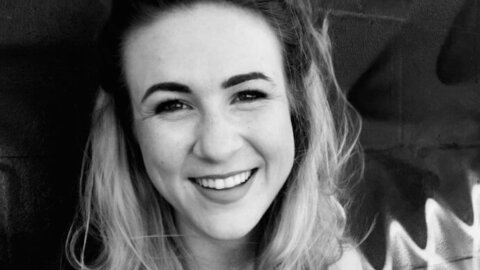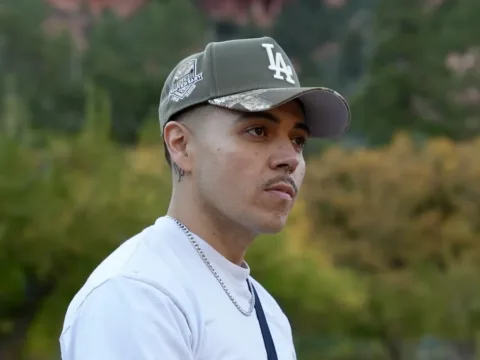MERGE Art Collective exists to facilitate collaborations between D/deaf and hearing visual and performing artists. It creates a space for deaf artists to inspire and educate hearing artists, and to form cross-cultural relationships through visual poetry, storytelling, and a new art form called “Visual PoeMusic.” Lana Norris asked five questions to Mia Hartley, Founder and Co-Artistic Director, about MERGE Art Collective’s vision, projects, and advocacy.
Let’s dive in! In MERGE’s mission statement, you talk about inspiring cross-cultural understanding through a bicultural performance experience. What was your path to learning Deaf culture as a hearing person, and what inspired you to co-found MERGE Art Collective?
My path to learning about Deaf culture has been very much inspired by people in the Deaf community whom I consider to be both dear friends and wonderful mentors. I began learning American Sign Language (ASL) purely out of interest, and it was my mentor Kellie Martin, who is the co-artistic director of MERGE Art Collective, who introduced me to the richness of her culture and native language. Without her guidance and friendship, the idea for MERGE Art Collective would not have come to fruition.
Learning about Deaf culture exposed me to visual poetry and storytelling, which are art practices that are unique to Deaf culture and its visual poets and storytellers: Douglas Ridloff, Peter Cook, and Dack Virnig, to name a few. Douglas states that visual poetry can help people to “create a space to imagine and envision new ways of communicating,” and “can push [hearing people’s] limitations and open them up to more abstract, flexible ways of thinking through concepts.” This is exactly what it did for me. It was through the discovery of these visual art forms and my love for music that we had the idea to combine the two. By combining these art forms, and by incorporating both D/deaf and hearing performers, we have created a space in which hearing musicians and performers are encouraged to learn bits of sign language and engage with an incredible genre of artwork they may not know about, while these D/deaf visual artists have the opportunity to have their poetry set to music that is performed by both hearing and D/deaf musicians.

Back row, left to right: Lisa Reynolds (ASL interpreter) Bryan McNamara (Baritone Saxophonist), Douglas Ridloff, Cole Belt (Bass Saxophonist), Thomas Giles (Baritone Saxophonist)
For its first project, MERGE Art Collective collaborated with Douglas Ridloff, founder of ASL Slam, and ended up performing Project 1: Visual PoeMusic at the Whitney Museum in New York City. Can you talk about the project and composition process?
It was such an incredible opportunity to work with Douglas; he created a visual poem specifically for our first Merge Art Collective collaboration. Seeing it performed for the first time at an ASL Slam event this past January and knowing that I was going to have to attempt to capture that visual beauty in my musical composition was equally as intimidating as it was exhilarating.
The entire project and compositional process was based around Douglas’s poem, and written for a saxophone quartet. The instrumentation of Singularity Saxophone Quartet shifted from the traditional four voices to having only the tenor, baritone, and bass saxophones; this made it so that the vibratory feedback of the music would be even greater. We built a wooden platform for Douglas, which also enhanced the vibration so that he could clearly feel the sound of the saxophones through the thinner medium of the box, as opposed to just the ground. Douglas served as the conductor through his movements, which determined the phrasing and pacing of the music. The composition had to be written alongside a video of Douglas performing the poem, and time-stamps from that video were used to shape the composition. A movement as subtle as the turn of Douglas’s left wrist at 0:20 in the video could be the visual cue needed for the tenor saxophonist to move on to the next phrase in the live performance; the music was all reliant upon him alone, which I think was a very freeing experience for him, expressively speaking.
The beauty of sign language makes it easy to imagine visual and performing artist work, but music is less obvious. What should hearing musicians know or do to encourage collaboration with D/deaf and hard-of-hearing artists?
I think one of the most important lessons that I have learned from Kellie is that communication must always be a two-way street. Learning about the native language and culture of another community of people, and allowing yourself to be vulnerable, is an incredible first step to showing respect for a culture that you do not belong to, but would like to learn more about. I would strongly encourage other hearing musicians who are wanting to learn more about visual poetry to take the time to learn about ASL by attending community meet-ups or events such as those put on by ASL Slam. Learning to communicate and allowing myself to be vulnerable to a new culture has provided me with new perspective and musical inspiration; it has been such a gift in this way.
One of our saxophonists and a member of Singularity Saxophone Quartet, Cole Belt, also shared some of his thoughts:
“I learned a fundamental bit of ASL prior to rehearsals so that I could at least make brief small talk with Douglas. I enjoyed the process of learning and communicating in ASL so much that I continued to learn through YouTube tutorials and going to ASL Slam events as a guest just to give myself more opportunities to practice speaking the language with the D/deaf community. Working with Douglas was and continues to be an inspiration on many levels. Aside from absolutely being on ‘artist level’ with his craft, he’s an excellent communicator to deaf and hearing alike. I’ve worked with him now on five separate occasions and each time it’s a warm, flexible, accommodating experience, and as a musician this is a refreshing experience.”

You’re returning from a Fulbright scholarship at University of London, Royal Holloway studying arts accessibility. What’s your perspective now on the United States scene and what accessibility means for D/deaf artists?
There are incredible opportunities in the arts that are offered through organisations such as ASL Slam and Deaf Spotlight all across the country. Many D/deaf people are already well aware of these organisations, I think it is us hearing people who could afford to learn more about the Deaf arts culture that is alive and thriving around all of us—right now as we speak! Being in the United Kingdom also exposed me to the awesome efforts of organisations such as DeafRave in London, whose founding members and artists are providing a platform for musicians and performers in their D/deaf community. I am hopeful that these artists will continue their mission and continue to educate hearing and D/deaf people alike about Deaf culture and the visual and musical artistry that has been born out of it.
Tell us what’s on deck for your 2018-2019 season!
We are in the process of developing a lot of new repertoire in preparation for our first full-length concert performance, set to take place this upcoming spring in New York. In the meantime, we plan to perform at upcoming ASL Slam-affiliated events and in venues throughout the New York City metropolitan area. Check out our website and Facebook/Instagram pages for our upcoming events and performances!
























